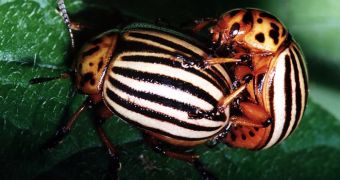A humble grass eating Mexican beetle turned in less than one century in one of the a world's worst agricultural pests. The Colorado potato beetle (Leptinotarsa decemlineata) is less than 2 cm (0.8 in) long and has 10 back black stripes. For centuries, it fed just on spiny plants and thorns. It could not attack potato simply because potatoes were not cultivated in Mexico during the Aztec time. The plant could not be cultivated in the clime of Mexico without modern agricultural methods.
But this beetle, one of the 20 of the genus Leptinotarsa lived on the leaves of a herbaceous plant, Buffalo bur (Solanum rostratum), closely related to the potato (Solanum tuberosum). During the rainy season, the female laid her eggs - from 20 to 500 - onto the leaves of the weed. The shiny colors of the adults warn birds and lizards that the beetle is not eatable: when attacked, it releases a stenchy liquid. The yellow larvae are not distinguishable from the flowers of the same color.
Various research fields, including genetics, re-made the journey of this beetle. Despite its name, this beetle did not originate in Colorado.
The journey of the beetle started in 1680, when the Mexican cowboys headed north with their cattle for selling them in Texas. The beetles accompanied them, grabbed on the spikes of the weeds they ate, stuck on the coat of the cattle. This way, the beetle reached central Texas, and went further north with the seasonal migration of the bisons, whose dense and woolly coat made the ideal place for the grasping seed-filled capsules of the plants.
The potato had not yet entered the scene. This plant was first found by Europeans in Peru (Inca Empire) in 1531. In 1533, the Inca Empire was conquered by the conquistadors of Francisco Pizarro and the potato was used for feeding the Inca slaves and prisoners. By 1570, Spain was already cultivating potatoes. In 1586, British Islands (Ireland included) cultivated them as well. In 1719, potato stocks were exported back from Ireland to the New World.
Meanwhile, the beetle continued its eastward journey and, by 1819, it had reached the Great Plains of the middle US, being signaled by Thomas Say, a naturalist from Philadelphia, at the border between Nebraska and Iowa. Still, by that time the Colorado beetle had not passed to the potato.
This jump was made 4 decades later, and in 1859, their first boom was signaled. In 1860, they devastated the potato fields of Nebraska. In 1865, they devastated Illinois, Pennsylvania and Ohio. By 1872, potato crops on the northeastern American fields were hit by a Biblical calamity. Commercial ships covered their hatches with plates to protect themselves against the insect hordes. In New York, a train was blocked on its rails by the beetles and the passengers leaving the cabins had to make paths through the dead carcasses of the beetles. The beaches were also invaded.
In 1875, the beetle reached England. In 1876, it was signaled in the German port Bremen. The desperate efforts of the German and French authorities hampered the advance of the insect for a while. But the WWI gave a boost to the march of the Colorado beetle. By 1933, it invaded Spain, Belgium, Netherlands and Switzerland. The WWII also increased its range. In 1943, it boomed in Poland. Between 1945-1952, it was signaled in Czechoslovakia, Hungary, western USSR and Romania. Today, amongst the EU countries, only the UK, Republic of Ireland, Balearic Islands, Cyprus, Malta, Sweden and Finland are not infested with the Colorado beetle.
One issue must be cleared: contrary to the widespread belief, this beetle has nothing to do with the Irish great crisis of the potato, that triggered the massive Irish immigration to North America during the 19th century. That was caused by a fungus.

 14 DAY TRIAL //
14 DAY TRIAL //